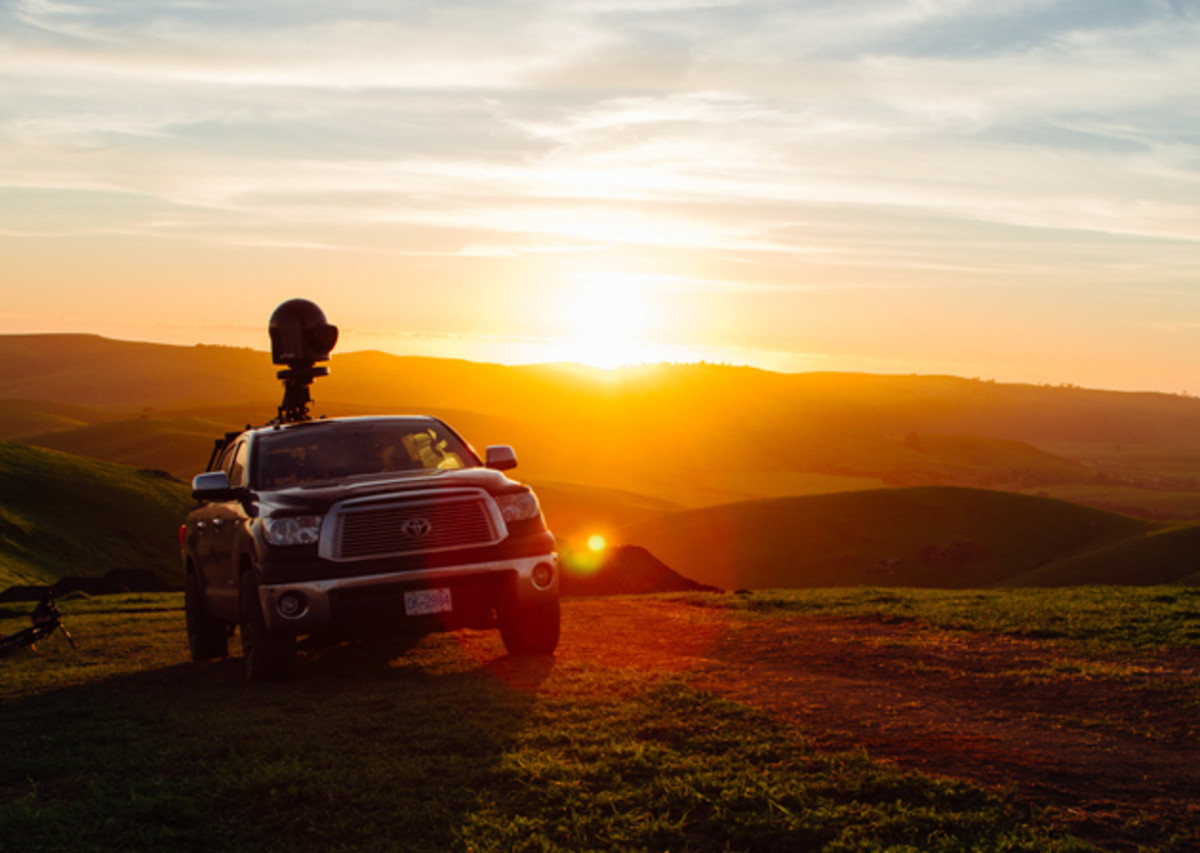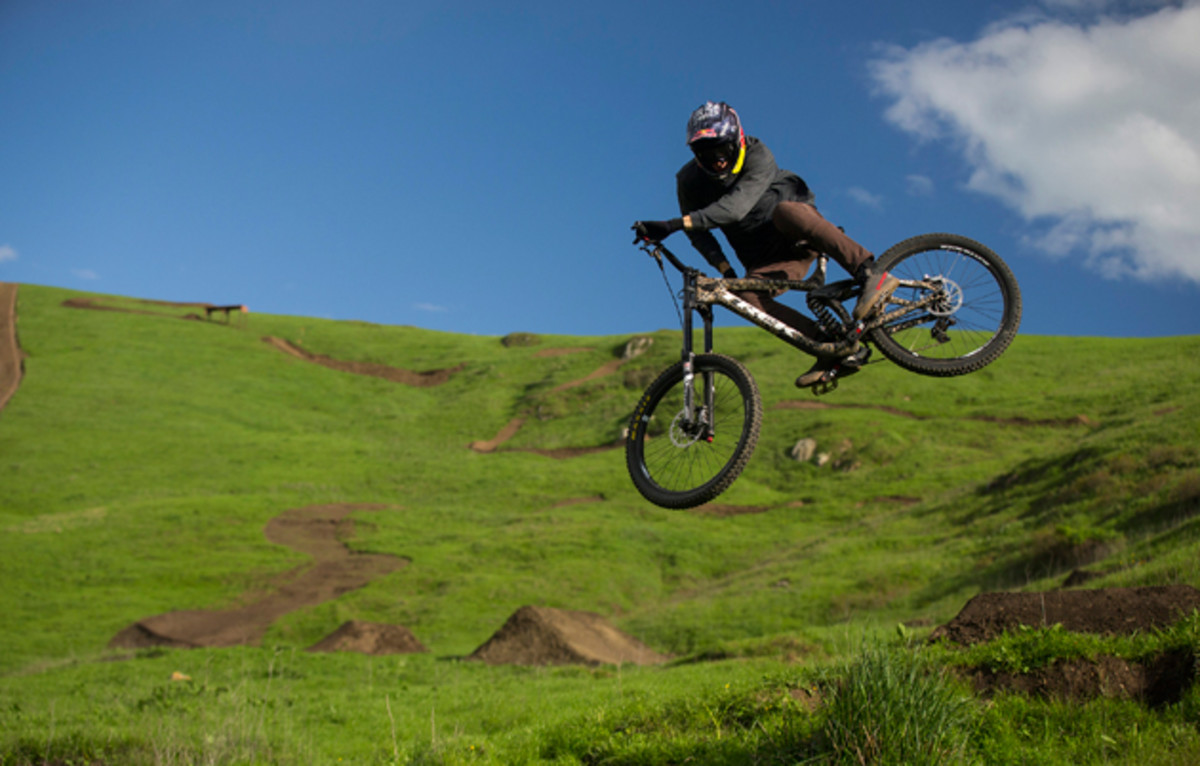Mountain biker Brandon Semenuk’s unReal video: Long shot pays off

For decades—since long before Brandon Semenuk was born—mountain bikers have regaled each other with tales of those exceedingly rare-but-wonderful moments spent aboard the “flow train.” It’s a seemingly altered state, when rider and bike and trail just work together seamlessly, rolling along without a hiccup or hesitation. But it was Semenuk, and the talented crews at Anthill Films and Teton Gravity Research, who finally captured the essence of the flow train on film.
In a YouTube clip that has gone viral (more than two million views as of early August), Semenuk rips an outrageous top-to-bottom line on a custom track along a verdant hillside in Cambria, Calif. The segment, filmed in early March for the mountain bike movie unReal, is completely unedited. First take, start to finish.
“It’s never happened before, to spend that amount of time for one shot,” says Darcy Wittenburg, Anthill’s co-producer. “What was unique about this is, if we hadn’t gotten that shot, there was no salvaging of the segment.
“In any other situation, we’re slowly gathering clips. So if the rider gets injured 70 or 80% of the way through the shoot, you can find a way to make it work. If Brandon had gotten to the bike drop, and twisted his ankle, and was out for a week or two, we would have spent all that time and all that money on absolutely nothing. And every single one of us knew those were the stakes. That put an unbelievable amount of pressure on Brandon.”
The idea of the “long shot”—a single, unedited take—had been discussed for a decade by the crew at Anthill Films, a small Canadian company from the fat-tire utopia of Squamish, B.C. Wittenburg says the goal was to recreate the sensation of driving beside a rider rolling along a dream trail.
“The main thing was to capture the feeling for a rider to ride that line,” he says. “If you could be with him the whole time, you could capture the essence of mountain biking.”
The 24-year-old Semenuk, a Whistler, B.C., native and sponsored rider for Trek, Red Bull, SRAM components, and Troy Lee Designs, was the ideal candidate. The challenge for the film crew, said TGR cameraman Brian Wulf, was matching Semenuk's two-wheeled wizardry.
“From the filming perspective, [we had] to try and raise our level of execution, to try to meet Brandon’s level,” says Wulf. “They’re two separate disciplines, but we can combine both aspects and take them to a higher level.”
BMX rider Scotty Cranmer pushes to make a dangerous sport a little safer
Of course, audience members see only Semenuk, a solitary cyclist pedaling along the custom-built track. What the audience doesn’t see is the nearby Toyota Tundra pick-up, with the crew of four packed into the cab, and the remote-controlled GSS—or Gyro-Stabilized Systems—camera mounted in the bed. (Check out this PinkBike video for a behind-the-scenes look.)
“It was definitely more of a team effort than any other project I’ve done,” says Semenuk. “Just the fact that we had to work in sync, and they had just as much stress as me.”
That stress began with a finite timeline. Before putting a spade in the ground, the Anthill crew had to find the right location, and persuade the landowners to allow the track to be built. That track had to highlight Semenuk’s slope-style and downhill skills.
“We knew what we wanted,” says Wittenburg. “That was a mountain that had at least 500 feet or more of elevation, and we wanted open, grassy fields. Not too steep, but just steep enough.”
The track and corresponding road reveal the amount of work required to pull off the segment. Build crews arrived in February, and spent three weeks carving the route and fashioning a variety of elements that gave the segment the necessary eye appeal.

“Then, on top of the track, we built the road,” says Semenuk. “So, a couple of days before we got the shot, I was in an excavator, building a road on the side of a massive valley, just for the truck and the camera.”
The lush valley made for a stunning backdrop. The truck made for a more intimate experience.
“The key to making these films is a certain focal length to capture the speed and the scale,” says Wittenburg. “If we had a camera on a drone, with a really wide angle [lens], we wouldn't get the feeling of the speed in which Brandon moves over the landscape. We can get a feeling of the ground changing as he moves.”
Wittenburg says that Anthill has done shorter unedited segments from a helicopter. But those “really didn’t have that feeling that this one did of the rush you get when the camera is low to the ground,” he explains. “That's why we did it with a truck.”
The access road had to be built last, to make certain it never appeared in the final film.
“We thought that would take the magic away a little bit if you could see the road we were on,” says Wittenburg. “We wanted the road crossing to happen really quickly, so you don’t even see it.”
Semenuk was also dealing with a wrist injury, sustained in a crash just before the shoot. That further reduced the margin for error. Concerned that exacerbating the injury could impact his season, Semenuk visited a local hospital, where he consulted with a surgeon who was also an avid mountain biker.
“He gave me a splint, told me to wear it for 24 hours, take a bunch of Ibuprofen,” says Semenuk. “He said, ‘If you take it off and it feels better than it did before, then do it. If it feels the same or worse, don’t do it.’
“So I took a day off practice, was fully immobile, took some Ibuprofen. Then I took the splint off and rode around a bit. It felt a little better, so I said we’ve got to get the shot.”
Still, Semenuk and the film crew weren’t out of the woods. “The other huge factor is wind,” says Wittenburg. “When you get rolling hills like that, they’re usually quite exposed.”
Those winds would pick up early afternoon like clockwork, making Semenuk’s aerial maneuvers too unpredictable to risk. Plus, the GSS camera needed to be packed up and shipped to another location the next day.
Training with Ian Walsh: Building mind and body to take on the biggest waves
“We had bike difficulties, we had camera difficulties, we had track difficulties, plus the weather and wind,” says Semenuk. “At one point, we experienced a problem with everything. And we didn't have an unlimited timeline.
“When we got to the end of the shoot, this camera that we absolutely needed for the shot had to go. This was the very last day. We got up early, because we had two hours before the wind picked up again, and the light was going to get bad. So we had two hours to get this shot, or else it wouldn’t have happened.”
Semenuk and the crew pulled it off. Starting with Semenuk’s slow stroll to the hilltop, the camera never leaves the rider. The track quickly transitions from a series of rollers and berms into big elements that has the high-flying Semenuk doing backflips.
The critical juncture comes at a rock cliff, where Semenuk dumps his slope-style rig—a Trek Ticket S—spins quickly counterclockwise, grabs his downhill-specific Trek Session 9.9 and steps off a 12-foot precipice. Semenuk makes the drop-in look almost casual. But his ability belies the degree of difficulty inherent in the move.
“It was very difficult, because when you’re on one bike, it has a very distinct feeling,” says Wittenburg. “When you switch bikes, suddenly all the nuances and subtleties are totally different. You've got to switch your brain.

And Brandon also wanted to do that without stopping. That’s where he came up with the idea of the caveman drop off that cliff. It’s impressive.”
All the while, the crew had to maintain a proper speed to ensure the camera kept pace with Semenuk as he accelerated on the lower section of the trail.
“When I got to the bottom, I thought ‘Awesome, I did it,’” says Semenuk. “But I know that the filmer’s job was just as hard or harder than my job. So I was just waiting to hear a cheer, or something, to know that they got the shot. So, I thought, ‘OK, I did my part, but I might have to do it again in case something went wrong.’”
Wulf, behind the camera, assumed that take would the first of several.
“I turned to one of the directors and said, ‘He's going to ride it again, right?’ And Brandon came up, watched it, and said: ‘No. That’s good work,’” says Wulf. “As a filmmaker, I'm a perfectionist, and sometimes you kind of get lost in your own craft. I would have loved to have done it again, but I wasn't the one putting my neck out there.”
The relief afterward was palpable.
“It was about 11 in the morning when we got the shot,” says Wittenburg. “It was pretty exciting. The whole ride home, we were all just floating.”
For the accompanying soundtrack, Anthill's Darren McCullough chose a song twice as old as Semenuk. “For What It’s Worth,” was written by Stephen Stills, recorded by his band Buffalo Springfield in late 1966, and released in early ’67. It is still considered one of the top 100 songs of all time by Rolling Stone.
“I didn’t know that was the song they chose until I actually saw the movie,” says Semenuk. “But I was really excited about it. It’s an awesome track.”
The same can be said of Semenuk’s flawless run, and the flawless shot that captured it in a single take. Classic flow train.
